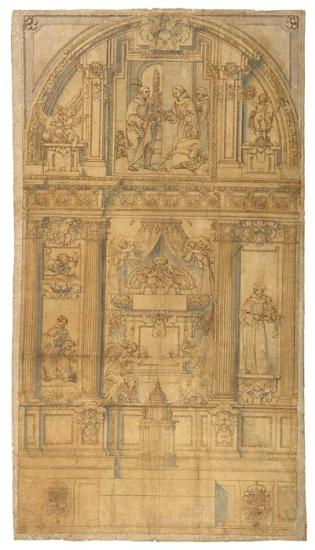
Design for the Altarpiece of the Chapel of San Diego de Alcalá, Convent of Santa María de Jesús, Alcalá de Henares
Purchased as the gift of Mrs. Charles Wrightsman, 1986
CANO'S GREATEST DRAWING
This monumental design is undoubtedly Cano's masterpiece on paper. Composed of seventeen joined sheets, it served as a plan for the altarpiece of the Chapel of San Diego de Alcalá. Philip IV became patron of the chapel in 1657, and his coats of arms appear at the lower left and right of the drawing. The highly finished execution indicates that this was a presentation drawing, offering the king different options to consider, including a proposed painting of St. Francis at lower left and a proposed sculpture of St. Anthony of Padua at lower right.
From the sixteenth to nineteenth centuries, Spain witnessed the rise of the Catholic Church along with the flourishing of court artists who explored deeply spiritual visions. Concurrently, the nightmare of the Inquisition drove artists to probe the darker side of human nature through scenes of martyrdom and torture. Drawing played a central role in their conception of these diverse subjects—from Murillo's preparatory studies for painting commissions to Goya's private albums satirizing contemporary society. In addition to this rich tradition in Spain, Spanish artists also worked abroad, notably in Naples, which was a Spanish territory.
Visions and Nightmares marks the first exhibition of Spanish drawings at the Morgan, whose holdings in this area are small but significant. Showcasing over twenty sheets by Spanish artists spanning four centuries, this selection traces the shifting roles and attitudes toward the art of drawing in Spain.
This online exhibition was created in conjunction with the exhibition Visions and Nightmares: Four Centuries of Spanish Drawings, on view January 17 through May 11, 2014 and organized by Edward Payne, Moore Curatorial Fellow.
This exhibition is made possible by the A. Woodner Fund.
